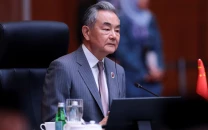The change that never came
Change will not come through one election or one campaign, but through concerted, long-term efforts and endurance.

The writer is the Chairperson of the History Department at Forman Christian College, Lahore
First, the incidence of violence in K-P, Balochistan and Karachi did not significantly affect voter turnout. For example, in NA 237, Thatta-I, the voter turnout was 58 per cent, and 61 per cent in NA 217, Khairpur-III, whereas NA 249, Karachi-XI witnessed 61 per cent and NA 245, Karachi-VII had 54 per cent turnout. Therefore, there was not much difference between voter turnout between rural and urban Sindh. Similarly, the percentage of difference between voter turnout in Peshawar and Charsadda, the most violent districts in the run-up to the elections, did not differ considerably from other districts in K-P not affected by violence to that extent. This means that largely, whoever wanted to vote on May 11, voted, and that only a small percentage was deterred by the threat of violence.
Secondly, despite claims of a huge surge in turnout, it only increased by 11 per cent. What does this mean? While 55 per cent is still a very high percentage, yet it simply matches the turnout in the 1977 elections and falls below the 1970 election figures. If we compare this turnout with neighbouring countries, then, too, the turnout looks unsatisfactory. In India, the last four general elections have had 58 to 62 per cent turnout, in Bangladesh, the last election in 2008 witnessed an 85 per cent turnout and the two before that had around 75 per cent turnout and in Sri Lanka, the last election in 2010 had over 60 per cent turnout, while the two earlier ones had around 75 per cent turnouts. In my city of Lahore, it seemed that the ‘get out the vote’ drive by all the political parties, NGOs, the media, educational institutions, etc. would significantly increase the turnout with people predicting 70 per cent turnout as easily achievable. However, in the end, the 13 seats of Lahore witnessed a turnout ranging from a low of 49 per cent to a high of only 64 per cent in one constituency — most constituencies hovered around the mid-fifties mark. Why?
One: one should not expect voter turnout to dramatically increase from one election to another. Democracy might be more firmly entrenched in Pakistan, but it by no means remains unchallenged. Also, the democratic experiment has yet to provide dividends for the voters to come out. The performance of democratic governments has to improve to influence the voter enough to vote on election day. Two: voting has a lot to do with state structures and integration. People will come out to vote if the government (central or provincial) matters to them in their daily life. If the government is something peripheral, then there is simply no reason to waste time. This factor explains why there is always a low voter turnout in K-P and Balochistan and a comparatively higher one in Sindh and Punjab — the depth of the government and level of integration are crucial here. Three: higher turnout also depends on parties, which should have grassroots organisations that are largely democratic, too. It is at the village/ward level that party workers encourage and lead people to vote, not the grand leaders. Very few parties have that level of organisation and democracy in Pakistan. And four: the feudal and semi-feudal system needs to be broken in the country to, in effect, “free” people to vote. These four factors are what distinguished Pakistan led by the Muslim League and India led by the Congress in 1947 and still continue to haunt us.
Pakistan can achieve a much higher voter turnout and can become a working democracy, which helps people change their lives; however, this change will not come through one election or one campaign. It will come through concerted, long-term efforts and endurance.
Published in The Express Tribune, May 28th, 2013.
















COMMENTS
Comments are moderated and generally will be posted if they are on-topic and not abusive.
For more information, please see our Comments FAQ